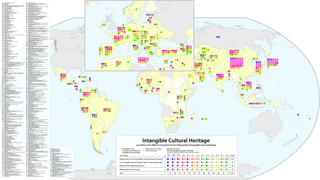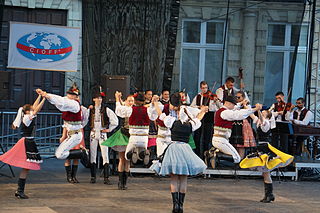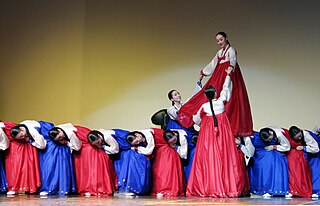
Ifugao, officially the Province of Ifugao, is a landlocked province of the Philippines in the Cordillera Administrative Region in Luzon. Its capital is Lagawe and it borders Benguet to the west, Mountain Province to the north, Isabela to the east, and Nueva Vizcaya to the south.
The Proclamation of Masterpieces of the Oral and Intangible Heritage of Humanity was made by the Director-General of UNESCO starting in 2001 to raise awareness of intangible cultural heritage and encourage local communities to protect them and the local people who sustain these forms of cultural expressions. Several manifestations of intangible heritage around the world were awarded the title of Masterpieces to recognize the value of the non-material component of culture, as well as entail the commitment of states to promote and safeguard the Masterpieces. Further proclamations occurred biennially. In 2008, the 90 previously proclaimed Masterpieces were incorporated into the new Representative List of the Intangible Cultural Heritage of Humanity as its first entries.

Lapuyan, is a 3rd class municipality in the province of Zamboanga del Sur, Philippines. According to the 2020 census, it has a population of 27,737 people. The municipality of Lapuyan is located in the southern section of the Zamboanga del Sur province. It is also often referred to as "Little America".
An intangible cultural heritage (ICH) is a practice, representation, expression, knowledge, or skill considered by UNESCO to be part of a place's cultural heritage. Buildings, historic places, monuments, and artifacts are cultural property. Intangible heritage consists of nonphysical intellectual wealth, such as folklore, customs, beliefs, traditions, knowledge, and language. Intangible cultural heritage is considered by member states of UNESCO in relation to the tangible World Heritage focusing on intangible aspects of culture. In 2001, UNESCO made a survey among states and NGOs to try to agree on a definition, and the Convention for the Safeguarding of the Intangible Cultural Heritage was drafted in 2003 for its protection and promotion.
The Center for Folklife & Cultural Heritage (CFCH) is one of three cultural centers within the Smithsonian Institution in the United States. Its motto is "culture of, by, and for the people", and it aims to encourage understanding and cultural sustainability through research, education, and community engagement. The CFCH contains (numerically) the largest collection in the Smithsonian, but is not fully open to the public. Its budget comes primarily from grants, trust monies, federal government appropriations, and gifts, with a small percentage coming from the main Smithsonian budget.

Jongmyo jerye (Korean: 종묘제례) or jongmyo daeje (종묘대제) is a traditional rite held for worshipping the deceased Joseon monarchs in Jongmyo Shrine, Seoul, South Korea. It is held every year on the first Sunday of May. The jongmyo rite is usually accompanied with the court music playing (Jerye-ak) and dance called Ilmu or line dance. Jongmyo jerye and jeryeak were designated as Masterpieces of the Oral and Intangible Heritage of Humanity by UNESCO in 2001.

The Subanon are an indigenous peoples of the Zamboanga peninsula area, particularly living in the mountainous areas of Zamboanga del Sur and Misamis Occidental, Mindanao Island, Philippines. The Subanon people speak Subanon languages. The name is derived from the word soba or suba, a word common in Sulu, Visayas, and Mindanao, which means "river", and the suffix -nun or -non, which indicates a locality or place of origin. Accordingly, the name Subanon means "a person or people of the river". These people originally lived in the low-lying areas. However, due to disturbances and competitions from other settlers like the Moros, and migrations of Cebuano speakers and individuals from Luzon and other parts of Visayas to the coastal areas attracted by the inviting land tenure laws, further pushed the Subanon into the interior.

UNESCO established its Lists of Intangible Cultural Heritage with the aim of ensuring better protection of important intangible cultural heritages worldwide and the awareness of their significance. This list is published by the Intergovernmental Committee for the Safeguarding of Intangible Cultural Heritage, the members of which are elected by State Parties meeting in a General Assembly. Through a compendium of the different oral and intangible treasures of humankind worldwide, the programme aims to draw attention to the importance of safeguarding intangible heritage, which UNESCO has identified as an essential component and as a repository of cultural diversity and of creative expression.

The International Council of Organizations of Folklore Festivals and Folk Arts is an international nongovernmental organization (NGO) in Official partnership with UNESCO and is accredited to provide advisory service to the Committee of the UNESCO Convention for the Safeguarding of Intangible Cultural Heritage. CIOFF has 63 full members, 21 associate members and 18 corresponding members worldwide and 3 partner members. Its headquarters are in Confolens in France. Full members are National Sections with the aim to preserve traditional art, to organize Folklore Festivals or similar activities as well as unite voluntary organizations, working in the field of dance, music, costumes, customs and ethnography. The National Sections belong to sectors in the organization according to their geographic location.

The Convention for the Safeguarding of the Intangible Cultural Heritage is a UNESCO treaty adopted by the UNESCO General Conference on 17 October 2003.

Ramman is a religious festival and ritual theatre of the Garhwal region in India. It is a festival of the Garhwali People celebrated in many villages of the region. Although there are many Rammans, such as the Jak Ramman, one of the most popular is the masked Ramman of the Saloor Dungra village of the Painkhanda Valley in the Chamoli district in Uttarakhand, India.

The heritage preservation system of South Korea is a multi-level program aiming to preserve and cultivate Korean cultural heritage. The program is administered by the Cultural Heritage Administration (CHA), and the legal framework is provided by the Cultural Heritage Protection Act of 1962, last updated in 2012. The program started in 1962 and has gradually been extended and upgraded since then.
Biosphere reserves are areas comprising terrestrial, marine and coastal ecosystems. The biosphere reserve title is handed over by UNESCO. Each reserve promotes solutions reconciling the conservation of biodiversity with its sustainable use. Biosphere reserves are 'Science for Sustainability support sites' – special places for testing interdisciplinary approaches to understanding and managing changes and interactions between social and ecological systems, including conflict prevention and management of biodiversity. Biosphere reserves are nominated by national governments and remain under the sovereign jurisdiction of the states where they are located. Their status is internationally recognized.
Intangible cultural heritage (ICH) includes traditions and living expressions that are passed down from generation to generation within a particular community.
Al Sadu, or simply Sadu, describes an embroidery form in geometrical shapes hand-woven by Bedouin people. Sadu House in Kuwait was established by the Al Sadu Society in 1980 to protect the interests of the Bedouins and Sadu weaving.

The term Paramount Ruler, or sometimes Paramount Datu, is a term used by historians to describe the highest ranking political authorities in the largest lowland polities or inter-polity alliance groups in early Philippine history, most notably those in Maynila, Tondo, Pangasinan, Cebu, Bohol, Butuan, Cotabato, and Sulu.
Timuay Imbing was the Timuay or ancestral leader of the Subanen people the Zamboanga peninsula in the Philippines during the American colonial Period. One of the most prominent Thimuay in Philippine history, he is perhaps best known for his role in introducing Evangelical Protestantism, through the Christian and Missionary Alliance Churches of the Philippines, to the Subanon people, and for establishing the settlement which would become the present-day municipality of Lapuyan, Zamboanga del Sur.

Mibu no Hana Taue (壬生の花田植) is ritual of transplanting rice that is held every year on the first Sunday of June in Kitahiroshima, Hiroshima, in hopes of a good harvest. It is a traditional event. It has been designated as an Important Intangible Folk Cultural Property of Japan and is listed in the Representative List of Human Intangible Cultural Heritage of the UNESCO Convention for the Safeguarding of Intangible Cultural Heritage.











